The leaves of trees have the key function of photosynthesis. Roots and leaves allow trees to grow and develop. If you like ornamental trees and do not know what kind to plant in your garden, I will help you choose a tree with heart-shaped leaves.
Transform your garden into a romantic oasis with these stunning trees with heart-shaped leaves.
If you want to add a touch of romance to your garden, consider planting trees with heart-shaped leaves. These stunning trees provide shade and beauty and add a whimsical and romantic element to your outdoor space. Here are 13 trees with heart-shaped leaves, including options with large heart-shaped leaves that make your garden a romantic oasis. In this list, you will see deciduous trees (lose their leaves during winter) and evergreen heart-shaped trees (which remain green all year round and are my favorites).
There are many species of trees with heart-shaped leaves, and in this article, I will explain the advantages and disadvantages of each type of tree. Some trees can have extensive roots and are not suitable for planting in any garden.
Let’s start to discover the perfect addition to your outdoor space! Enjoy our Beautiful Trees with Heart-Shaped Leaves for Your Garden review.
Table of Contents
What Is a Tree with Heart-Shaped Leaves
Heart-shaped leaves, also known as cordiform or cordate-shaped, are somewhat unusual and set themselves out from other oval-shaped leaves by having a broader base with a depression in the middle and a tapering tip.
When present in groups, these uncommon features may give each tree’s canopy a distinctive attraction found nowhere else: evidence of how unique each tree is.
Tree With Heart Shaped Leaves
Next, I will name several species of trees with heart-shaped leaves and explain a little about the care that these trees with heart-shaped leaves need. Each tree with heart-shaped leaves has different weather, soil, and development needs.
Red Heart Shaped Leaf: Flame Thrower Redbud Tree
Flame Thrower Redbud Tree, better known as Cercis canadensis ‘NC2016-2’, has heart-shaped leaves that maintain its beautiful fall color from spring through autumn. This tree is ideal for gardens with little space as it only grows between 15 to 20 ft (4.5 to 6 meters).
The University of North Carolina developed Flamethrower Redbush Tree. In an article from the university, you can learn more about how the Cercis canadensis ‘NC2016-2’ was created.
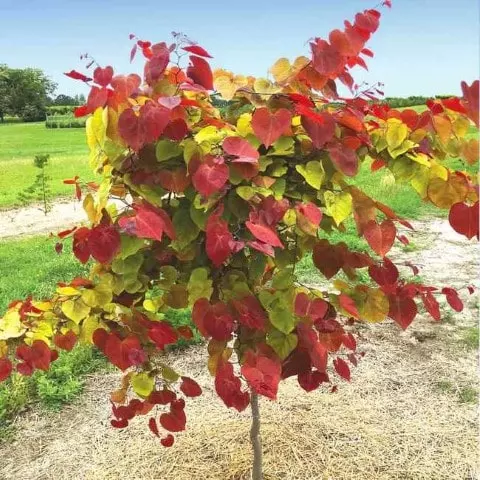
This tree grows well in USDA zones 5 to 9. It is a tree that does not require much care and prefers acid soils, although it adapts to other types of soils. For better development of the Flamethrower Redbush Tree, you can apply it at the beginning of spring fertilizer 5-10-5.
Tree With Large Heart Shaped Leaves: Silver Linden (Tilia tomentosa)
Silver linden (Tilia tomentosa) is a deciduous tree that can reach 115 ft (35 m) in height, with a pyramidal shape and smooth, whitish bark. It is a tree with heart-shaped leaves. It multiplies by seeds, which need stratification and treatments to break the impermeability of the coverings.
Silver linden is a fairly hardy species that, although it develops better in fertile soils, tolerates various types of soils, drought, and atmospheric pollution. It is growing faster than other species of the genus.
You can grow silver linden in USDA zones 4 to 7, and this tree prefers soils with a pH between 6 and 8. It is essential to plant silver linden in a garden that receives 6 to 8 hours of sunlight daily for its correct development.
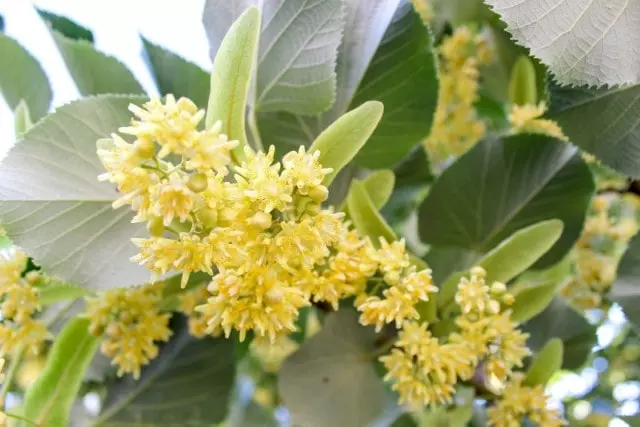
Henry’s Lime (Tilia henryana)
Henry’s Lime can reach 82 ft (25 m) in height, with tomentose branches that eventually become hairless. The leaves are oblique and broadly ovate, with a heart-shaped base and a short acuminate apex. The leaves of this tree with heart-shaped leaves are 2″ to 5″ (5-12.5 cm) long and 1.5″ to 2.7″ (3.5-7 cm) wide. The margin has scattered teeth ending in a sharp point. Flowers whitish in clusters of 20 or more flowers 4″ to 6″ (10-15 cm) long. Flower bracts of similar length, pubescent.
Tilia henryana performs very well in USDA zones 6 to 8. It prefers nutrient-rich and well-drained soils. Henry’s Lime can reach a height of up to 82 ft (25 meters).
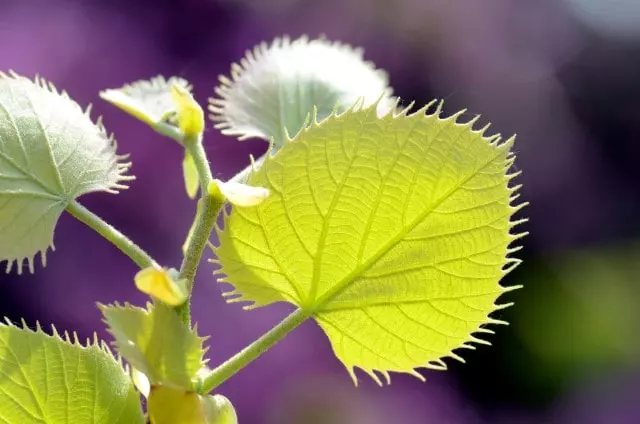
Caucasian Lime (Tilia × europaea)
Caucasian lime is a tree with heart-shaped, shiny, dark green leaves. Tilia × europaea is native to Europe and Western Asia. This tree can live up to 400 years and reach heights of up to 160 ft (50 meters).
Caucasian lime grows very well in soils with a pH of 6 to 8. This tree with heart-shaped leaves grows well in USDA zones 3 to 9. Plant the Caucasian lime in the garden, which receives at least 6 hours of sunlight daily.
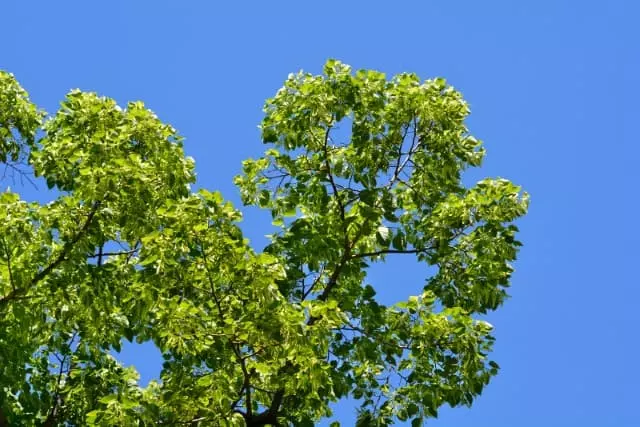
Evergreen Tree With Heart Shaped Leaves and White Flowers: Northern Catalpa (Catalpa speciosa)
Northern catalpa is a tree with heart-shaped leaves that grow very well in soils with a pH between 5.5 and 7. Catalpa speciosa is an evergreen tree that grows very well in USDA zones 4 to 8. Catalpas are very appropriate trees for gardens of all sizes because of their apparent ornamental value based on their various qualities.
The trunk and branches of the catalpa have a light color, forming an irregular structure that gives it a very romantic touch. Catalpas are suitable for good, fertile garden soil that does not suffer from waterlogging.
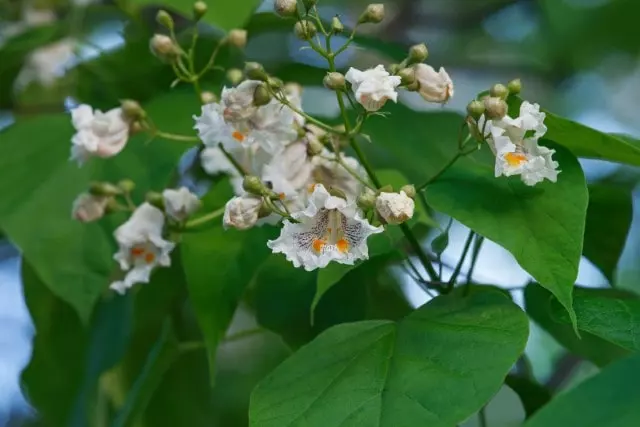
Linden (Tilia)
A Linden tree is a straight-stemmed tree with a smooth bark that reaches about 65 to 130 ft (20 to 40 m) in height. It is a tree with heart-shaped leaves, dark green on the upper side and bluish-green on the underside.
The fragrant flowers have a yellowish color, grouped in clusters. The flowers of this tree are widely used to prepare tea.
Linden is native to Asia, Europe, and part of North America, although it has been introduced almost everywhere for cultivation. Its life cycle can reach 900 years. Linden grows very well in USDA zones 3 to 7.
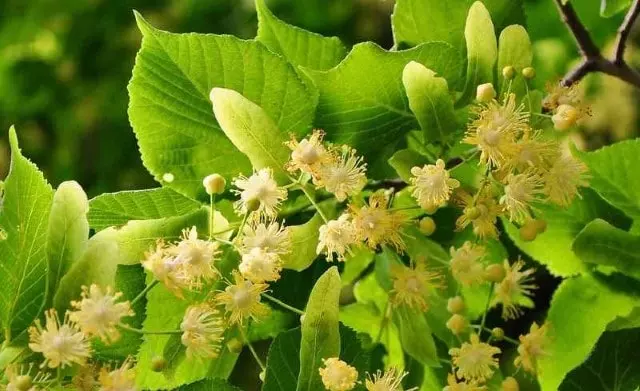
Princess Tree (Paulownia tomentosa)
The princess tree is gorgeous. Originally from China. Its scientific name is Paulownia tomentosa, and it receives other common names such as empress tree or foxglove tree. It is used as an ornamental plant, and its cultivation has spread due to its easy development. Its umbrella-shaped crown is seductive.
Paulownia tomentosa is a tree with big heart-shaped leaves. The princess tree can reach 89 ft (27 meters) in height, and its trunk can measure between 22 and 66 ft (7 and 20 meters) in diameter. Princess tree survives for 100 years and can sprout from the same trunk up to five times after being felled.
This tree develops well in USDA zones 7 to 10, where the average minimum temperatures range from 0 to 40 °F (-18 to 4 °C). The wood of the princess tree is considered very good and is used for many different items. Musical instruments, furniture, vehicle accessories, and various handicrafts are made. Learn more about how to grow Paulownia tomentosa.
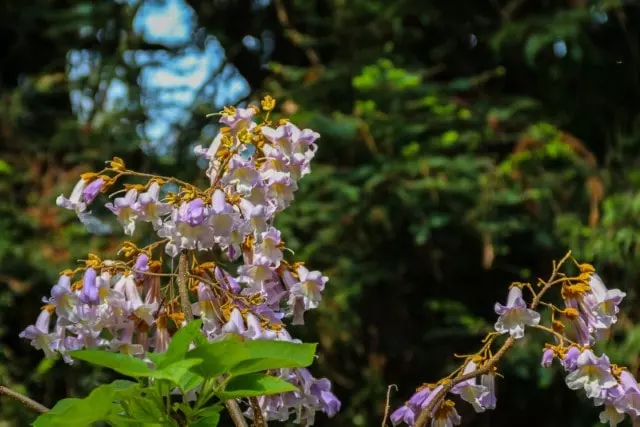
American Redbud (Cercis canadensis)
The American Redbud tree, also known as Cercis canadensis, is a beautiful tree with heart-shaped leaves that will add a touch of romance to any garden.
Cercis canadensis plant is a deciduous tree, commonly called the American Redbud, native to North America and sapling-shaped.
Deciduous, heart-shaped leaves, pale yellow in autumn. Abundant flowering clusters, fuchsia-purple in color, blooming in spring before the leaves are released. Tree to be grown as an isolated specimen or in rows.
The heart-shaped leaves of the Redbud tree are a vibrant green color and create a beautiful canopy of shade. Planting a Redbud tree in your garden will add beauty and attract birds and butterflies. It is a perfect addition to create a romantic oasis in your outdoor space.
The American Redbud is a small tree that grows up to 32 ft (10 meters) high. Cercis canadensis grows well in USDA zones 4 to 9. This tree prefers acid soils and a location where it receives at least 4 hours of direct sunlight.
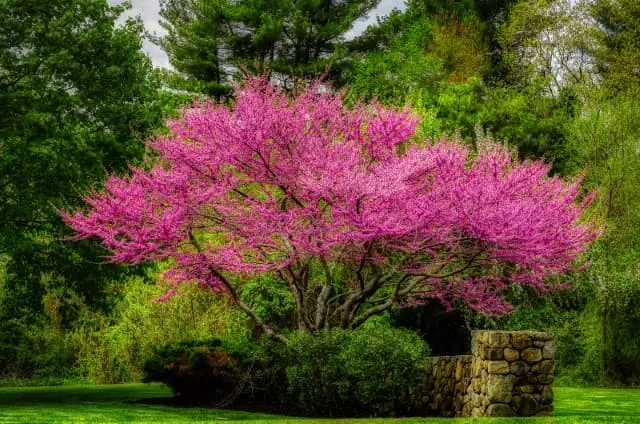
Quaking Aspen Tree (Populus tremuloides)
The Quaking Aspen tree is deciduous and easily exceeds 82 ft (25 meters) in height. It has a straight, thick trunk that can exceed one meter in diameter at the base. The smooth and whitish bark becomes cracked at the base over the years and acquires a dark color.
This tree with heart-shaped leaves grows very well in USDA zones 1 to 6 and prefers soils with a pH of 5.5. The quaking aspen tree can live more than 60 years, although there are records of some quaking aspen trees that lived more than 100 years.
The hanging inflorescence appears before the leaves in February-March (Northern Hemisphere). At the same time, the fruit in the capsule contains blackish seeds wrapped in a white flock as a strategy to promote their dispersal by the wind.
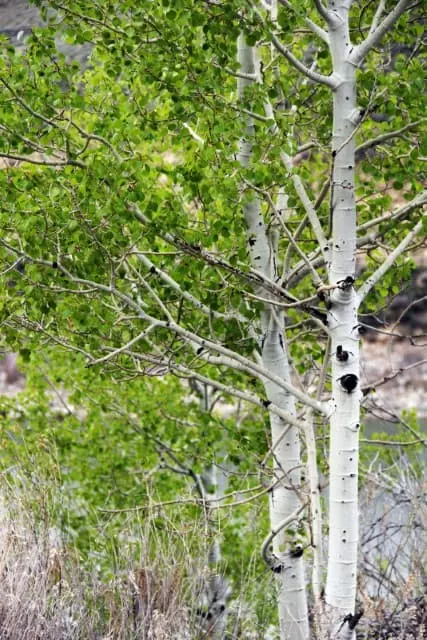
Southern Catalpa (Catalpa bignonioides)
Southern catalpa can grow up to 50 ft (15 meters). Because of its extended shape, it can reach up to 40 ft (12 meters) wide. Its bark is gray with reddish slits. It is a fast-evolving plant. It can develop irregular ramifications due to bad pruning.
Catalpa bignonioides tree has large heart-shaped leaves, smooth-edged, up to 8″ (20 cm) long, and deciduous.
This tree can withstand cold and develops well in USDA zones 5 to 9.
Southern catalpa is ideal for providing shade in the garden, especially in the lawn area, where it benefits from abundant watering. It requires a medium degree of maintenance.
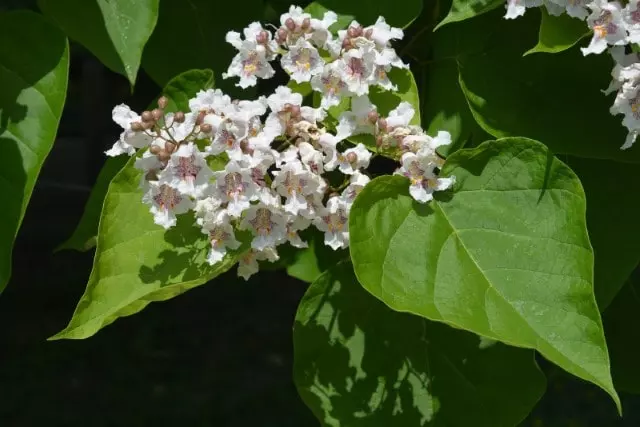
White Mulberry (Morus alba)
Morus alba is a deciduous tree species with a branched, leafy stem belonging to the Moraceae family. Known as white mulberry or simply mulberry, it is a native plant of China widely distributed in Asia, Southern Europe, and America.
White mulberry is a tree with heart-shaped leaves and bears delicious fruits. Mulberries are an important source of vitamin C. These trees grow no taller than 50 feet (15 meters) and develop well in USDA zones 5 to 10.
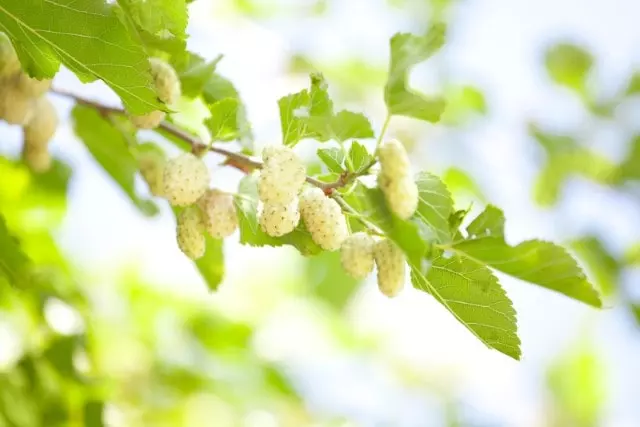
Italian Alder (Alnus cordata)
The Italian alder is a species endemic to southern Italy, including Sardinia and Corsica. Alnus cordata lives up to 4200 ft (1300 meters) above sea level from the plains.
Italian alder lives well in slightly acidic or basic soils but prefers moderately neutral soils. Alnus cordata tolerates impoverished soils well, thanks to its ability to fix nitrogen. It can live in soils with poor drainage. This tree lives in clays, silts, or sandy or loamy substrates.
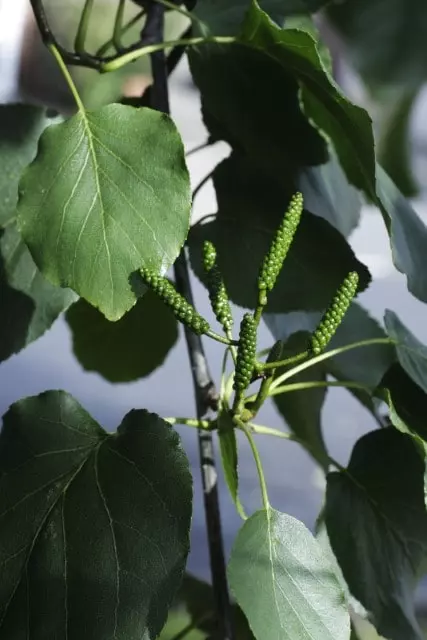
Handkerchief Tree (Davidia involucrata)
Davidia involucrata also known as the handkerchief tree or ghost tree. It is a spectacular and original species cultivated in large gardens in Europe and the United States. It belonged to the Cornaceae family and was discovered by the Franciscan missionary Father Armand David. This tree is native to southern China.
This tree has large heart-shaped leaves, which can reach a crown of 82 ft (25 meters). The trunk has smooth, gray bark with branches.
The flowers are in compact clusters with reddish centers, two bracts, and white petals that resemble handkerchiefs or pigeon wings. It takes between 8 and 10 years to flower.
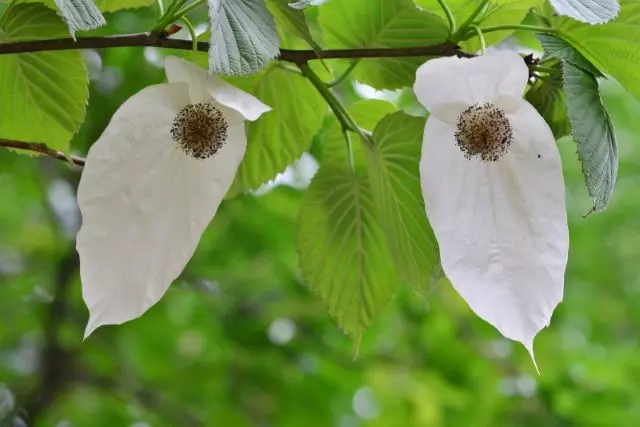
Final Conclusions About Tree with Heart-Shaped Leaves
As you can see, many species of trees have heart-shaped leaves. If you want to plant any of these trees with heart-shaped leaves in your garden, you only have to choose the right one according to your weather and soil type.
I am sure this article will guide you to transform your garden into a romantic oasis with these stunning trees with heart-shaped leaves, large leaves, and evergreen or deciduous giant flowering trees.
Recommended reading: how to plant a tree

